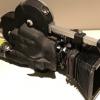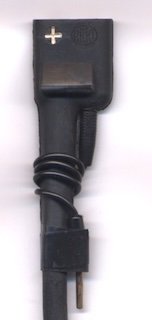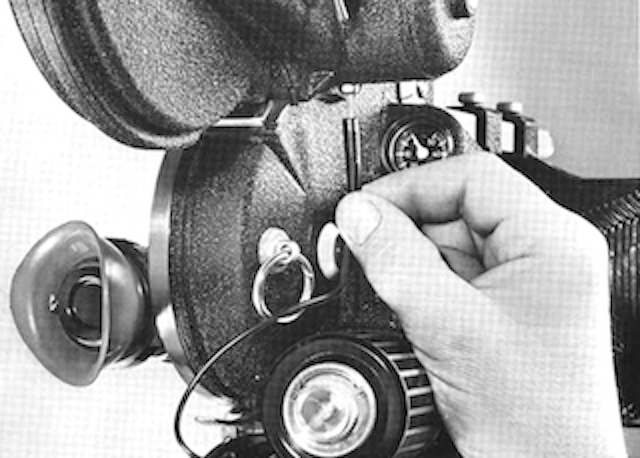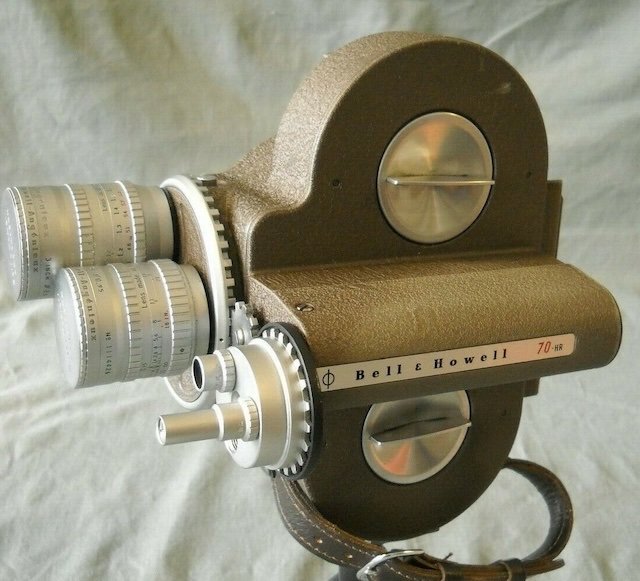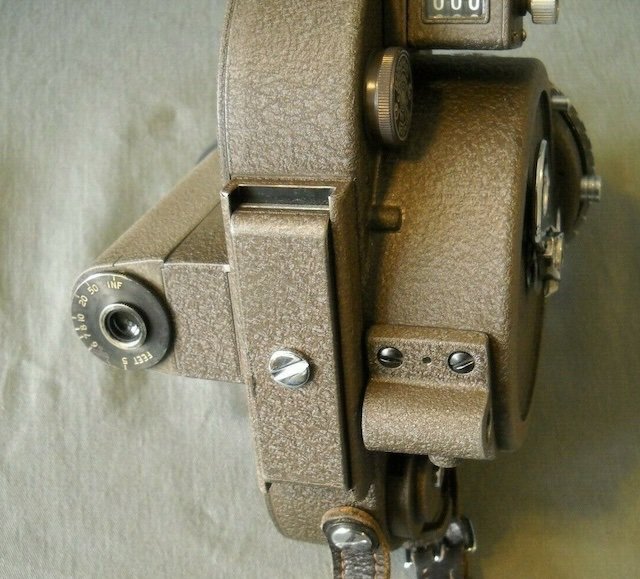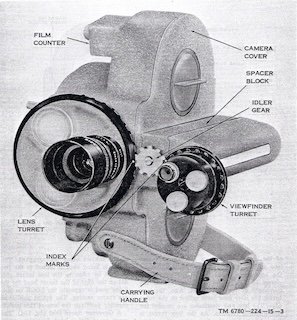
Charlie Peich
Basic Member-
Posts
278 -
Joined
-
Last visited
Profile Information
-
Occupation
Cinematographer
-
Location
USA
Recent Profile Visitors
-
Have you tried using the ground wire that came with the camera? One end is plugged into the power cord (the negative side), and the other end was plugged into the torque motor. Sometimes the grounding on the torque motor to the camera body didn't make very good physical contact. Not all cameras had this problem. See the 2 pics... This little wire had a habit of wandering away never to be seen again 🤷♂️
-
Hello Jack....... I've attached an ad from an Alan Gordon 1983 catalog showing your camera. Unfortunately it doesn't mention your 24 volt power supply with the 2 cables. Your best bet would be to open the camera and see how the wires are attached before sinking any more money into this camera. You will have to enlarge the ad in order to read it. 🙁 (my guess would be those plug into 2 12 volt batteries... just a guess!!) Your next concern would be getting hold of the magazines loaded with film. Or, you could load them your self after countless hours trying to load them in the dark. 1st, you would have to spool down the film into 50ft loads of DOUBLE PERF film on a small core (found in the mag), then load the magazine. The magazines are old, and are prone to jamming in the camera. Even Kodak loaded magazines back in the day would occasionally jam 🤷♂️. There are articles about loading them on the net. There may be one place that sells preloaded mags...... 'Film Photography Project'. https://filmphotographyproject.com/16mm-magazine-film-now/ After WW-II, there were a couple of guys modifying the GSAP camera and had mounted a finder on the unit. I have a multi page article on modifying the GSAP camera (lots of pics) that was written after the war. To big a file to post here, so if you want it, send me an email address through the forum. Good luck! Charlie
-
Bell and Howell Filmosound 302 Upkeep and Maintenance
Charlie Peich replied to Scott Barton's topic in Bell + Howell
302 and 8302 operating instructions Link to pdf file: https://acrobat.adobe.com/id/urn:aaid:sc:va6c2:cc8d78ab-0353-46d0-a6e8-19b5ebc5be90 -
Bell and Howell Filmosound 302 Upkeep and Maintenance
Charlie Peich replied to Scott Barton's topic in Bell + Howell
Greetings Scott! Looking at this thread, I see nobody has answered your original question: "But there has been some information that I have seen that there is a drive-gear within the units that are plastic and when they break it is essentially a terminal condition. But also that their use was not consistent throughout the product line over the years but was introduced at some point. So my question to the group is if anyone knows if my units might contain these potentially problematic parts or if they might (hopefully) precede them? Any information on preserving these projectors would be appreciated. Thanks." A quick answer is..... NO, there are no plastic drive-gears in your 302, 8302 projectors. There are no plastic parts in the drive train nor the intermittent movement. (proof below) While the cracked nylon worm gear was a hot topic way back, those gears were in the successor to the FilmoSound 100-302 projectors, the FilmoSound 500 series. Apparently, the grease used on the gears in the new machines did not mix well with the nylon worm gear, and over time the gear cracked: In worse case scenarios, they fell apart, and the projector stopped working. Ouch. (a shocking photo to scare you)....... Then service people started making replacement worm gears out of better material. It solved the problem. Yes, changing them out was a real challenge. Back to the 8302 projectors....... Lubrication....... Does your 8302 projectors have the 3 oil cups on the top of the gear box? The earlier ones did. Then B&H came up with the phrase "permanently lubricated" projectors just before they changed over to the 500 series, which were..... permanently lubricated. No more getting oil on your fingers I guess. B&H also did that with their silent 16mm projectors and their popular reg 8mm projector the 122. Jeeeez, how hard is it to put a couple of drops of oil in your expensive projector?🤷♂️ This info is from a 1970 service manual for the 8302. I have a service manual dated 1958. No mention of 'permanently lubricated' projectors in the earlier manual. No oil cups on gear box.... Basically, B&H stopped building their original all metal mechanical projectors and created the new models. This changed occurred in the late '60s and early '70s. Go to Paul Investor's web site and you will find manuals for the 8302 projectors. There is a manual that is the parts manual, and you can see in the exploded views how your machine is made. https://www.paulivester.com/films/projector/manuals.htm One last item, there was another feature on the 8302-L models that may have been standard for that version. I have not seen this on any other projectors. It's the disc at the top of the aperture plate. It is a disc you adjust cropping the top and bottom of the projected frame. B&H 302 & 8302 service manual, Page 9 - 10 part # 24 'Aperture Plate Assembly, Variable'. Does your machine have that? So, which model 8302 do you have? I have an 8302-L model with a tube amp that doesn't have oil cups. Does that mean my permanently lubricated projector is still good after 55 some years? Charlie P.S. Do you have an operating instruction manual for your 8302? I have one, but it's for the earlier 8302 models. Need it? -
WTB: B&H Filmo 70DR/HR Viewfinder
Charlie Peich replied to Okto Simaia's topic in Marketplace Listings Under $200 / €200
Okto, Have you found a finder or the parts to cobble one together for your 70HR? Parts are scarce now. What motor did you get with your camera? Does the motor work? The previous owner probably removed the HR finder and spacer block to accommodate a Zoom lens with a reflex 'dog leg' finder. Fairly common back then. Too bad the original HR finder wasn't sent along with your camera. Be careful adapting a DR door and finder. There are slight differences between the DR door and DR finder and the HR door and HR finder. It all depends on how much you want to spend and how you are going to use the camera. Charlie -
I found this pic of the cover with 'Oel' on it in an auction on eBay....... https://www.ebay.com/itm/166553521094?hash=item26c75d0bc6:g:DH0AAOSwABxlptJe The seller does not include the model 'A' designation for the camera in his description. Looking at this camera in the auction, it appears this camera was used in a blimp. Arri introduced their 1st blimp with the introduction of the Model IIA camera. A brief history of Arri's 35mm camera... This was written by Kling Photo, Arri's 1st importer of Arri equipment in the USA. I'm thinking that the 1st IIA's had the cover with 'Oel' printed (the model II did not have a cover over the movement). Then at some point they changed it to the English spelling 'Oil'. But, why did they change it?? You are right about the cover for the IIB. I have a Model IIA that was built in the 2nd half of 1957, it has 'Oil' on the cover....... My camera built in Germany was sold by Arri to its 1st owner in Sweden. Why would they leave an English word on the cover? I bought my camera from a private individual, so it did not go through the USA importer when I acquired it. You are right about switching the labeling on the the cover for the 11B model. A way to quickly identify the IIB??? Also, there weren't that many changes to the IIB camera. Charlie
-
Fabian........ The plot thickens....... ???
-
-
Is this what you have?
-
70HR/KRM info, instruction manual, tips
Charlie Peich replied to Philip Forrest's topic in Bell + Howell
Mike, I should have added the following info about the spring belt for the 400ft mag in my previous post. The Spring take-up Belt for 400ft mag: Bell & Howell part number: Spring Belt Part # 10089 metal spring: 14 5/8" long & 5/32" diam. overall looped hook at each end. The size of the 2 looped hooks DO NOT figure into the length of the belt! (B&H edict) The 1st generation of the 400 ft mag used a "Loading clip" to hold the light valves in the magazine open when the small plunger was pushed in (red arrow). This makes it easy to push the film through the magazine openings. A 'Shepards Hook' it was called Worked like this (clever idea)... Well, those were easily lost and you never see them on eBay. One should be included with each 400 ft mag! (I only have 2 of them) In the later years B&H came up with a smaller device to accomplish opening the valves, the 'Magazine Loading Key' This was screwed on before loading film in the dark. It opened the light valves. The arrow points to the plunger. It is screwed on the magazine mounting screw for the camera. After you loaded your film in the dark, and while in the dark, you would take this key off to close the valves so your film wouldn't be exposed while mounting the mag to the camera. Then you would put this key in a very safe place so it won't get lost. lol When the mag was mounted on the camera and the film threaded, you put the lid or door on the camera, the door would push against the lever in the back by the opening in the body, and then open the valve so the film can flow freely. Red arrow. If you want to run the camera and visually see how the film is moving, you have to remember to push that lever to open the valves so the film won't jam. A lot of juggling!! What the magazine throat looks like: Figure it out? Have you checked this system to make sure the film is flowing easily from the magazine? Charlie -
70HR/KRM info, instruction manual, tips
Charlie Peich replied to Philip Forrest's topic in Bell + Howell
Contact this guy on eBay (yes I know, eBay) I bought Eyemo take-up springs from him before. He has the lists and knows the size of the spring you need. https://www.ebay.com/itm/350166571709?hash=item51878ddabd:g:9UkAAOSw~~Rf4PY5 Fast service! Charlie -
New IMAX Film Cameras in Development
Charlie Peich replied to Tim Tyler's topic in Cinematography News
Hello John! The proper name is 'Geoff' Williamson. You might try googling again with that combination. Mr. Williamson released a Wilcam W-4 in the 1st part of 1983. I attached a short write-up about it that was published in a popular industry magazine...... Geoff Williamson made several other cameras.... Super 8 single system mag sound for news filming, 16mm single system mag sound for news filming, 2 - 35mm quiet production cameras, a 35mm 300fps camera and this 65mm camera. Charlie -
Greetings Duncan! "I just know it's going to be something stupid, like with "MOS Camera"... Close.... 'DOM' is the 1st 3 letters for......... are you ready for this? .... 'DOMestic' Noun: something produced or manufactured in one's own county. Arri USA used 'DOM' exclusively to identify any Arri camera equipment that was designed and manufactured in the USA, not at the main factory in Germany. This was when Arri Germany and Arri USA were separate organisations. The most popular item was the DOM Animation/Time Lapse motor for the 16S and 16M cameras. Way back in the mid '50s, there was an interest in 'single framing' with these 16mm cameras. The cameras were not really designed for single frame operation, but Arri offered this 'lightweight' motor in April 1956... Meanwhile, back in Germany Arri factory made 'The Single Frame Gear'. This unit fit in between the camera and the drive motor. Not very popular in the U.S., in my opinion. So , Arri USA continued making and refining the DOM unit and ended with this version in the late '60s, early '70s. You still had to get a capping shutter which came from Germany. Hope that answers your question... Charlie
-
Alan Gordon gear device for Arri 16 - might be 716GE-5 ?
Charlie Peich replied to Duncan Brown's topic in ARRI
Oooops, forgot to add the pic of the NCE motor adaptors........


.thumb.jpg.32a8ef180f0966e046cc1cf4d178ccdf.jpg)



